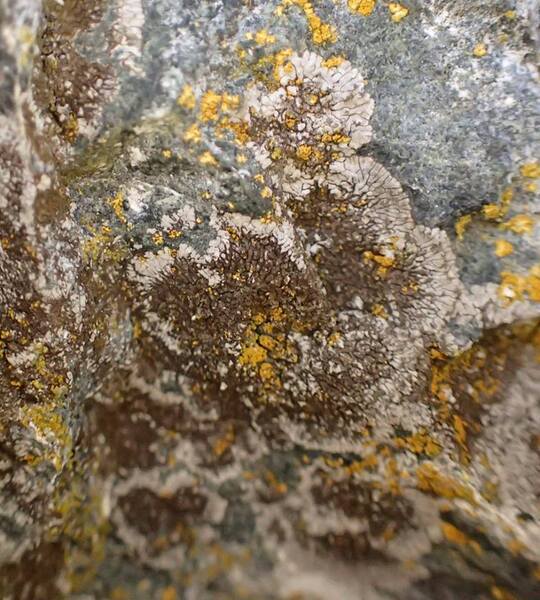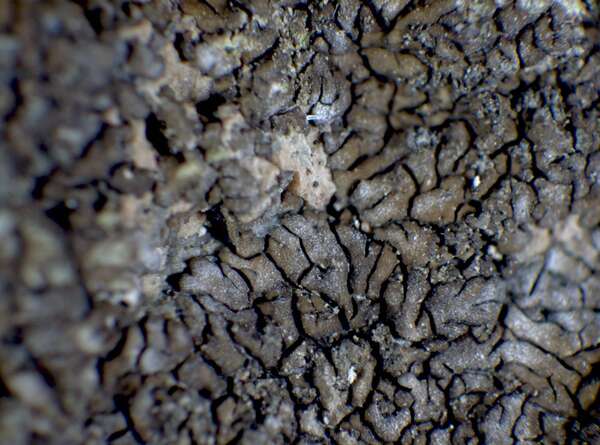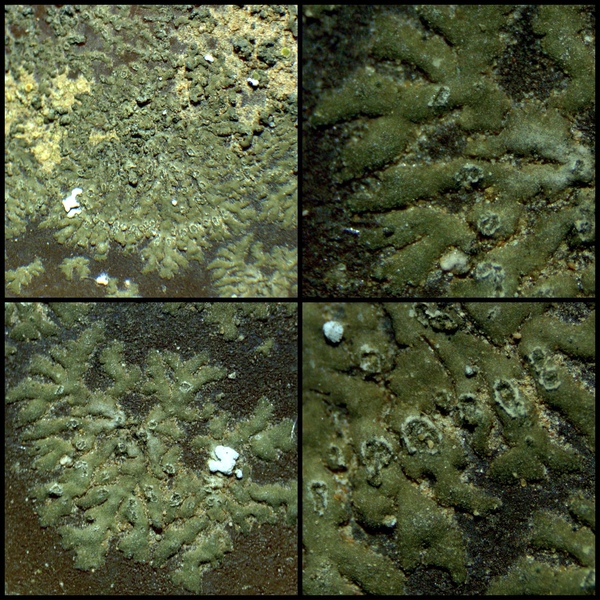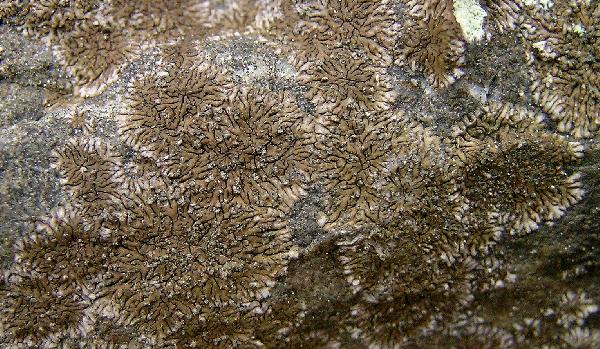Olegblumia demissa (Flot. ex Körb.) S.Y. Kondr., Lőkös, Jung Kim, A.S. Kondr., S.O. Oh & Hur
in Kondratyuk & al., Index Fungorum, 466: 1, 2020. Basionym: Imbricaria demissa Flot. ex Körb. - Syst. Lich. Germ.: 80, 1855
Synonyms: Caloplaca demissa (Körb.) Arup & Grube; Lecanora demissa (“Flot.”) Zahlbr.; Lecanora incusa (Flot.) Vain.; Rinodina castanoplaca (Nyl.) H. Olivier; Squamaria elaeina var. saxicola Beltr.
Description: Thallus crustose-placodioid, episubstratic, firmly attached, pale to dark brown to almost black in sunny situations, often greyish-pruinose in central parts, up to 0.15 mm thick, forming regular to irregular, up to 1 cm wide rosettes, several thalli often merging to cover larger surfaces. Lobes 1-1.5(-2) mm long, (0.1-)0.3-0.5(-0.8) mm wide, flat to weakly convex, divided into 2-3 secondary lobules towards the tips. Soralia mainly in the centre of thallus, laminal, at first punctiform, then irregularly rounded, concave, 0.3-0.5 mm wide, finally sometimes elongated and fissure-like, brownish to brownish green, those in the central parts of thallus often coalescing. Soredia 30-50 μm thick, becoming blastidiate-isidioid, grey-brown to dark brown or brownish green. Cortex 30-40 µm thick, with a brown pigment which dissolves in K forming colourless crystals; medulla white, prosoplectenchymatous. Apothecia not known. Pycnidia rare. Conidia bacilliform to narrowly ellipsoid, 3.5-5 × c. 1 µm. Photobiont chlorococcoid. Spot tests: cortex and medulla K-, C-, KC-, P-, UV-. Chemistry: thallus with vicanicin and caloploicin.
Growth form: Crustose placodiomorph
Substrata: rocks
Photobiont: green algae other than Trentepohlia
Reproductive strategy: mainly asexual, by soredia, or soredia-like structures (e.g. blastidia)
Subcontinental: restricted to areas with a dry-subcontinental climate (e.g. dry Alpine valleys, parts of Mediterranean Italy)
On otherwise dry surfaces with short periods of water seepage after rain
Commonnes-rarity: (info)
Alpine belt: absent
Subalpine belt: absent
Montane belt: extremely rare
Dry submediterranean belt: extremely rare
Humid submediterranean belt: very rare
Padanian area: absent
pH of the substrata:
1 2 3 4 5
Solar irradiation:
1 2 3 4 5
Aridity:
1 2 3 4 5
Eutrophication:
1 2 3 4 5
Poleotolerance:
0 1 2 3
Altitudinal distribution:
1 2 3 4 5 6
Rarity
absent
extremely rare
very rare
rare
rather rare
rather common
common
very common
extremely common
Loading data...
Occurrence data
Predictive map
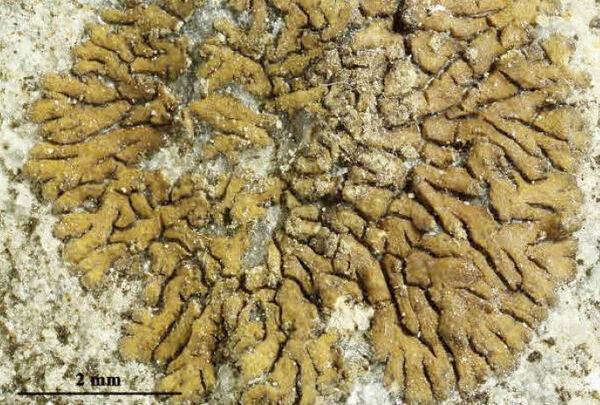
Felix Schumm CC BY-SA 4.0
Korea, Prov. Gangwon-do, beside Maengbang beach, around Mt. Deokbong-san, Hamaengbang-ri, Gundeok-myeoun, Samcheok city, 37°23’19.57’’ N, 129°14’21.23’’ E, 4-10 m, on rocks.
Leg. K.H. Moon (14694) and H. Kashiwadani.
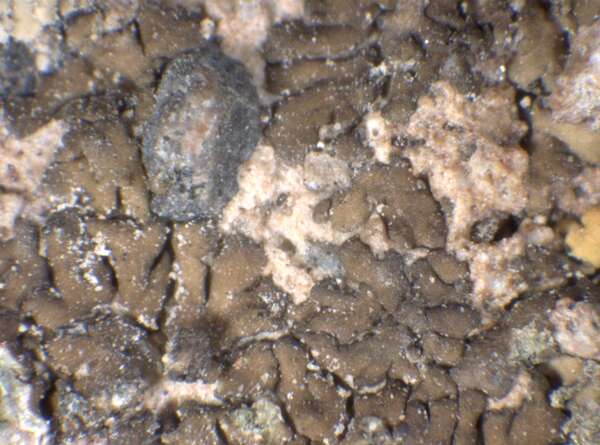
P.L. Nimis; Owner: Department of Life Sciences, University of Trieste
Herbarium: TSB (10065)
2002/05/17
Growth form: Crustose placodiomorph
Substrata: rocks
Photobiont: green algae other than Trentepohlia
Reproductive strategy: mainly asexual, by soredia, or soredia-like structures (e.g. blastidia)
Subcontinental: restricted to areas with a dry-subcontinental climate (e.g. dry Alpine valleys, parts of Mediterranean Italy)
On otherwise dry surfaces with short periods of water seepage after rain
Commonnes-rarity: (info)
Alpine belt: absent
Subalpine belt: absent
Montane belt: extremely rare
Dry submediterranean belt: extremely rare
Humid submediterranean belt: very rare
Padanian area: absent
pH of the substrata:
| 1 | 2 | 3 | 4 | 5 |
Solar irradiation:
| 1 | 2 | 3 | 4 | 5 |
Aridity:
| 1 | 2 | 3 | 4 | 5 |
Eutrophication:
| 1 | 2 | 3 | 4 | 5 |
Poleotolerance:
| 0 | 1 | 2 | 3 |
Altitudinal distribution:
| 1 | 2 | 3 | 4 | 5 | 6 |
Rarity
absent
extremely rare
very rare
rare
rather rare
rather common
common
very common
extremely common
Loading data...
Occurrence data
Predictive map

Felix Schumm CC BY-SA 4.0
Korea, Prov. Gangwon-do, beside Maengbang beach, around Mt. Deokbong-san, Hamaengbang-ri, Gundeok-myeoun, Samcheok city, 37°23’19.57’’ N, 129°14’21.23’’ E, 4-10 m, on rocks.
Leg. K.H. Moon (14694) and H. Kashiwadani.



